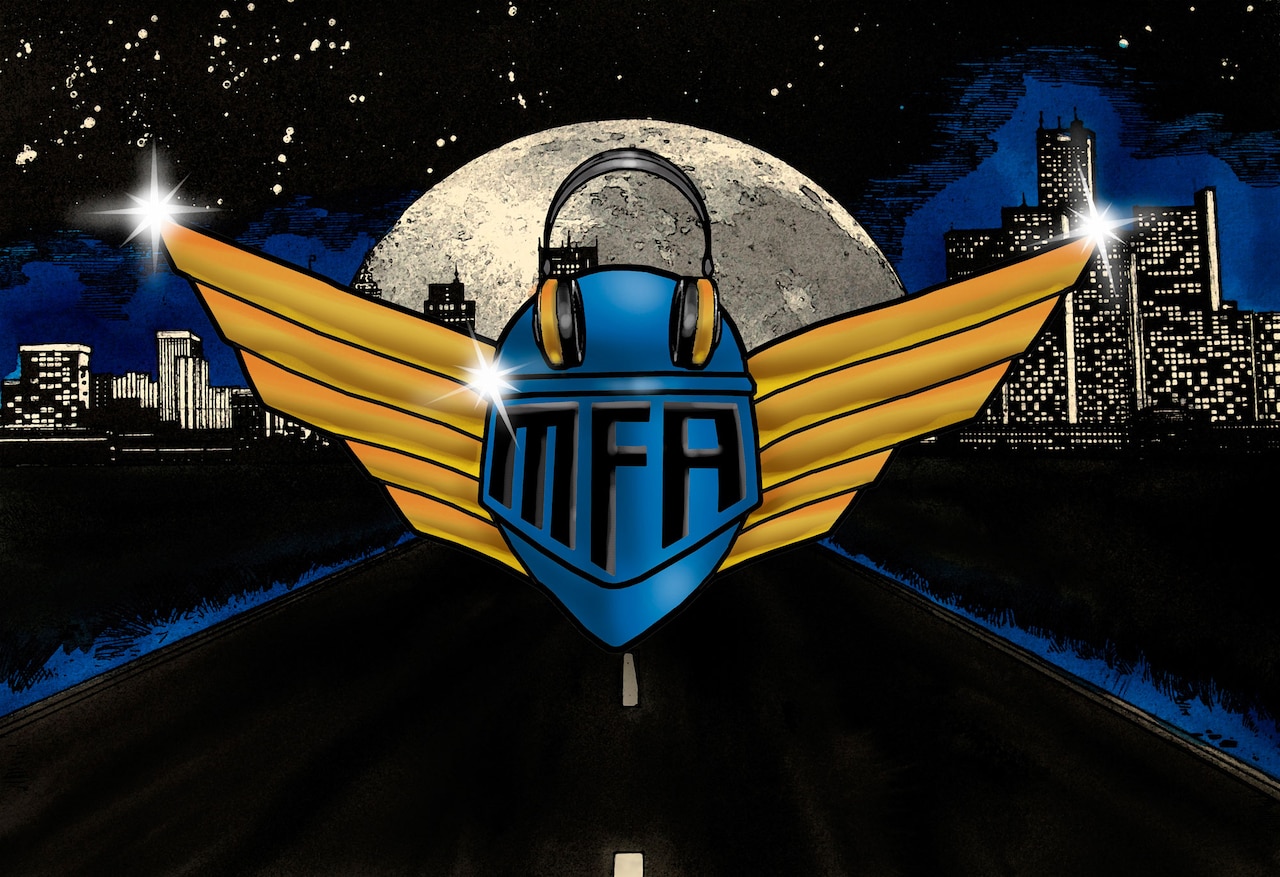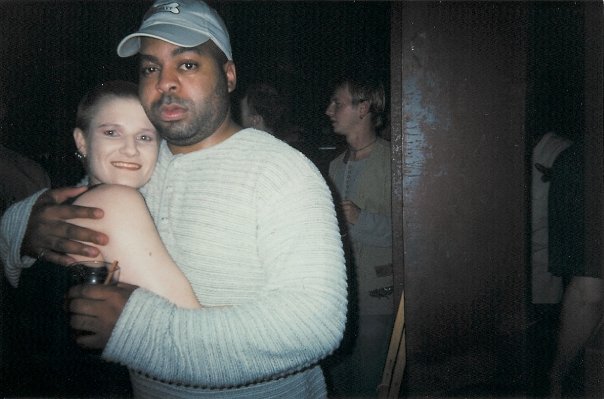Theater of the Mind: The Legacy of the Electrifying Mojo
Ask any Detroit techno artist about his or her influences and you’ll undoubtedly be regaled with stories about The Electrifying Mojo, a sci-fi visionary who ruled the Detroit airwaves while radio was still unrestricted. “He was an underground cult hero,” says Juan Atkins. “We would listen to him religiously every night.”
An enigma through and through, Mojo has rarely shown his face in public, refusing to be photographed and only granting a select number of interviews. Like the Wizard of Oz, Mojo was a voice behind a curtain or – in his case – a radio microphone. Although he mostly remains a mystery, his influence on Detroit techno is as clear as day. Mojo not only played the first techno records on air – A Number of Names’ “Sharevari” and Cybotron’s “Alleys of Your Mind” – but he also laid down a solid foundation of guitar funk and machine funk for techno’s development. “I think without The Electrifying Mojo, we wouldn’t have had Detroit techno the way that we know Detroit techno,” says Carl Craig
You’d sit there in a trance waiting for each record.
When Mojo – real name Charles Johnson – emerged on WGPR in 1977, AM radio had just flipped to FM, and there were only a handful of stations on the FM dial. And even fewer rules. “Mojo was on there playing whole album sides [up to 12 minutes long],” says Atkins. “He had a lot of range to experiment musically because he wasn’t under a tight format and he got really popular because of it.”
WGPR was primarily geared toward the black community with urban contemporary, R&B, soul, gospel and various ethnic programs, but Mojo didn’t adhere to any select format, a trademark of his persona that continued throughout his radio career at stations like WJLB, WHYT, and WMXD. As a result, his fan base was racially mixed, a rarity in an era that ordinarily had strict separations in listenership. Within one sitting, Mojo would swap out records from Peter Frampton to Genesis to Human League, followed by Parliament Funkadelic to Prince to Kraftwerk. Sometimes he’d do nights of all Prince or nights of all Michael Jackson, for three hours straight. “You’d sit there in a trance waiting for each record Mojo was going to play,” says Atkins.

Mojo’s shows kicked off with The Landing of the Mothership, an array of space-like sounds accenting Mojo’s “descent” to Earth, in which he’d often land on top of the Penobscot building, a staple in the downtown Detroit skyline. (Mojo’s mothership idea supposedly stemmed from Parliament’s Mothership Connection album.) During one lengthy landing, Mojo invited Detroit Mayor Coleman Young on air. Young, echoing as if from a distant planet, declares into the radio microphone: “This is Mayor Coleman Young aboard the mothership of Mojo. I’m flying over my city and looking at all of my people. I want to keep the city beautiful… won’t you help me? Mojo, let’s fly over Detroit, east and west, north and south... This is Mayor Young, and the mothership with Mojo…” Young’s voice trails off, as if forgetting to add the words “has landed.”
The same segment follows with a different ethereal voice, presumably Mojo’s: “Greetings to the privileged generation of Earth. One hundred years ago, millions of people across the expanse of your planet looked into the heavenly skies… and they asked the question, ‘What would life be like in the year 1981?’”
In Detroit, 1981 was an exciting time of change and evolution musically. The disco scene had morphed into New Wave/progressive, and it was also the year techno emerged. Even though the city was still recovering from the 1967 riots and Motown’s departure, Detroit’s music culture was vibrant. The Awesome segment of Mojo’s show, which followed The Landing of the Mothership, was entirely devoted to exposing listeners to the burgeoning sounds of Detroit’s underground, as well as funk and synth-laden (soon-to-be) hits from across the globe. It was during this segment that Mojo would drop early Detroit techno records. A year before, A Number of Names brought a demo of “Sharevari” to Mojo. Thanks to Mojo’s constant play of the track, by the time it dropped in 1981, it was already a dance floor hit.
Atkins, who had a similar experience with Cybotron’s “Alleys of Your Mind,” recounts how he got his music in Mojo’s hands: “I was making these demos and – being such a big Mojo fan – whenever I finished a record, I wanted him to play it. Derrick [May]
With a knack to foresee future trends, Mojo was pushing a scene and culture that would later be revered worldwide as the Detroit techno movement. “Mojo was a fantastic visionary,” says Craig. “He had a spiritual intergalactic quality to him. Mojo was playing music from around the world that was so impactful, not commercially but spiritually and creatively.”

Following the Awesome segment was Lover’s Lane, a short slow jams segment. But Mojo’s most famous segment was saved for last – the Midnight Funk Association. (It was the only segment that continued in every manifestation of Mojo’s show.) Called MFA for short, the Midnight Funk Association came complete with a special member’s card for devoted fans. “In the metro Detroit area, there are thousands… and more about to join now,” Mojo would croon at the beginning of the segment. “Will the members of the Midnight Funk Association please rise?”
Mojo would then ask listeners to turn on their porch lights and honk their car horns in an act of solidarity. “We would literally go on the porch and turn the light on,” recalls radio personality Lisa “Lisa Lisa” Orlando. “We would be in the car and would flash our lights and honk the horn... He made you think that this was really happening.”
One of Mojo’s most famous lines could be heard during the Midnight Funk Association. “Hold on tight, don’t let go,” he’d say. “Whenever you feel like you’re nearing the end of your rope, don’t slide off. Tie a knot. Keep hanging, keep remembering, that there ain’t nobody bad like you.” After calling the Midnight Funk Association to order and declaring, “May the funk be with you, always,” Mojo would drop the needle on funk and New Wave jams like Parliament’s “Flashlight“ or Gary Numan’s “Cars.” “He was playing New Wave before we even knew what it was,” says Stacey “Hotwaxx” Hale.
Mojo also championed the B-52’s, regularly playing the latter’s “Mesopotamia” and once hosting the band on his show. “We never pitched our music to any specific audience,” says Fred Schneider, frontman of the B-52’s. “The fact that Mojo [played our music on a black station]… our manager didn’t like the idea, but we didn’t care what he thought. We just wanted to reach whoever wanted to party and have a good time and liked our music, and Mojo liked it.”
Mojo also famously pushed the sounds of Kraftwerk, revealing the funk inherent in the German group’s drum machine rhythms. “Mojo introduced me to a more modern electronic sound,” says Craig. “Growing up in the ‘70s, you heard electronic music all the time, it was just more novelty stuff… like [Gershon Kingsley’s] ‘Popcorn.’ Mojo really brought the European angle of electronic music by playing Kraftwerk’s ‘Numbers’ all day long.”
But while the B-52’s and Kraftwerk often surface in discussions of Mojo’s legacy, he is perhaps best known for introducing Prince to the Motor City. “By the time Prince did Dirty Mind, Mojo was playing the hell out of him,” says Craig. Rather than playing Prince’s hits, Mojo preferred the B-sides and the rarities. “I heard a nine-minute version of ‘Sexy Dancer’ by Prince [through Mojo],” recalls Terrence Parker. Although Mojo rarely had guests on his show, he hosted Prince for an interview in 1986 following a concert at Cobo Arena. The end of the conversation highlights the love the two had for one another:
Prince: Mojo, guess what? We’re all going to see Purple Rain tonight.
Mojo: You are?
Prince: Yep!
Mojo: I’ve seen it 12 times.
Prince: I’ve seen it too many times, but I wanna watch it again.
Mojo: I’ve seen it 12 times, and I’ll go watch it tonight. Tell you what – I’m gonna ask everybody out there to go watch Purple Rain. What time will you be watching it?
Prince: About three minutes... they’re knocking on my door now. I’ll tell you what I’m gonna do. I’ll call back tomorrow and I’m gonna leave a little message at about 4:30. And, this one’s just for all the purple people, and I think they’ll understand. I’ll call you. I got your number.
Mojo: Alright! Prince, it’s been one big pleasure. Words cannot describe this moment. I don’t think words can describe how Detroit feels about Prince. So, in closing, whatever you want to say to Detroit... The airwaves are yours.
Prince: [makes five kissing sounds with his lips] Kiss.
Sometimes the Midnight Funk Association would go past 1 AM, but other times, Mojo would present rotating segments including Shout Out, where Mojo would give a shout out to every person who called in, and 35-35-35, where listeners could call in and suggest their favorite artist. Mojo would pick three, playing 35 minutes of each. There was also Journey, where he’d play music spanning one artist’s career, and Star Wars, where two artists would “battle” on-air and listeners would call in to choose the winner. “A couple of my favorite Star Wars [battles] were Kraftwerk versus The Soulsonic Force,” says Brendan M. Gillen
Star Wars eventually evolved into the Mixadome, a citywide mix-off competition. “Mojo invited all DJs to send in a cassette tape – it had to be at least a 15 minute mix with a maximum of 30 minutes,” recalls Parker. “He’d play one mix and then the other. And then he would have people call in to vote on which mix they liked best.” Parker, along with Atkins, Kevin Saunderson, and Anthony “Shake” Shakir, were all a part of the Mixadome. “It was a clever idea,” says Atkins. “Instead of hiring in certain mixers or having a mix show, why not have the ultimate mix show with these DJs battling each other?”
Yet no matter what segment Mojo continued from station to station, his “theater of the mind” concept continued through them all. What made the concept so powerful wasn’t just the music. In fact, he’d often stop the music to hold forth about Detroit, whether through poetry or discussions on cultural and societal issues plaguing the city, like crime and gang violence. The show was bigger than just music. It was about life.
The Mental Machine was Mojo minus the music, Charles Johnson unsheltered from his almost mythical radio guise.
In the mid-’90s, following the crack cocaine epidemic, Mojo released a limited edition poetry and prose book The Mental Machine. It was a deep dive into political and societal issues affecting both black culture and the world, with poems about teen shootings, prostitution, single mothers, the AIDS epidemic, and drugs – a continuation of messages often heard throughout his shows. He precedes each poem with statistics and a cry for change. “If our society continues to turn out violent children, the whole juvenile court system is antediluvian and should be realistically revamped for the protection of society from itself,” he writes before “$80.00 Mother,” a poem about an expectant mother shot to death by a teenager.
The Mental Machine was Mojo minus the music. It was Charles Johnson unsheltered from his almost mythical radio guise – a passionate individual rallying against political corruption and violence, a voice for peaceful and positive revolution. Mojo believed in his mission: When he was fired for talking too much (rather than playing music) on one of his stations, he allegedly shut down the transmitter and chained the studio doors shut, resulting in undisrupted dead air – probably the worst stunt one can pull in radio. While his whereabouts today remain a mystery, rumor has it that Mojo later worked as a program director for a handful of Detroit radio stations. Perhaps it’s better not to know, though. Some things are better left to the theater of the mind.
This piece contains material from A Spin on Frequency: A History of Dance Music Radio in Detroit.
Header image © Abdul Qadim Haqq

